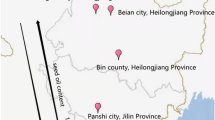Abstract
The Chemical compositions of the seeds of some wild plants have been investigated. The seeds ofHematostaphis berteri, Balanites aegytiaca andXimenia americana contain high levels of oils with values in the range, 38.2–54.5% (w/w). The iodine values of the oils were determined and, forXimenia americana, the value was high, i.e., 149.8 mg/100 g. The storage properties of the oil ofHematostaphis berteri were examined over a period of fifty six days by exposure to light at ambient temperature. The peroxide value of the oil over the period increased by 12-fold of its initial value of 27.5 mEq/kg, suggesting light susceptibility to photo-oxidative degradation. The proximate protein contents were low but the concentrations of mineral elements in the seeds examined were generally high, exceeding the values for the corresponding mesocarps by several orders of magnitude.
Similar content being viewed by others
Abbreviations
- IV:
-
iodine values
- PV:
-
peroxide values
- SV:
-
saponification values
References
Eromosele IC, Eromosele CO, Kuzhkuzha DM (1991) Evaluation of mineral elements and ascorbic acid contents in fruits of some wild plants. Plant Foods Hum Nutr 41:151–154.
Eromosele IC, Eromosele CO (1993) Studies on the chemical composition and physicochemical properties of seeds of some wild plants. Plant Food Hum Nutr 43: 251–258.
Cocks LV, Van Rede C (1966) Laboratory Handbook for oil and fat Analysts. London/New York: Academic Press, pp. 30–37, 107–130.
Bassir O (1971) Handbook of Practical Biochemistry Ibadan: Ibadan University Press, pp. 32–34.
AOAC (1970) Official Methods of Analysis, 11th ed. Washington, DC: Association of Official Analytical Chemist.
Snell FD, Snell CT, Snell CA (1961) Colorimetric methods of analysis, Vol 3. London: D Van Nostrand, p. 71.
Idigo MC (1989) Potential suitability of some local seed oils for paint alkyd resin synthesis. Nigerian J of Tech Education 6: 67–73.
De Lumen BO, Fiad S (1982) Tocopherols of winged bean (psophocarpus tetragonolobus) oil. J Agric Food Chem 30: 50–53.
A-Wandawi H, Al-shaikhly K and Abdul-Rahman M (1984) Roselle Seeds: A new protein source. J Agric Food Chem 32: 510–512.
Utz WJ, O'Connel PL, Storey R and Bower NW (1982) Nutritional evaluation of jojoba plant: elemental analysis of the seed meal. J Agric Food Chem 30: 392–394.
Al-Wandawi H (1982) Chemical composition of seeds of two Okara cultivars. J Agric Food Chem 31: 1355–1358.
Author information
Authors and Affiliations
Rights and permissions
About this article
Cite this article
Eromosele, I.C., Eromosele, C.O., Akintoye, A.O. et al. Characterization of oils and chemical analyses of the seeds of wild plants. Plant Food Hum Nutr 46, 361–365 (1994). https://doi.org/10.1007/BF01088437
Received:
Accepted:
Issue Date:
DOI: https://doi.org/10.1007/BF01088437



